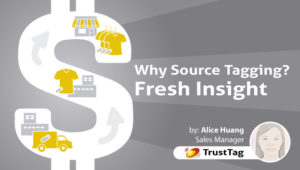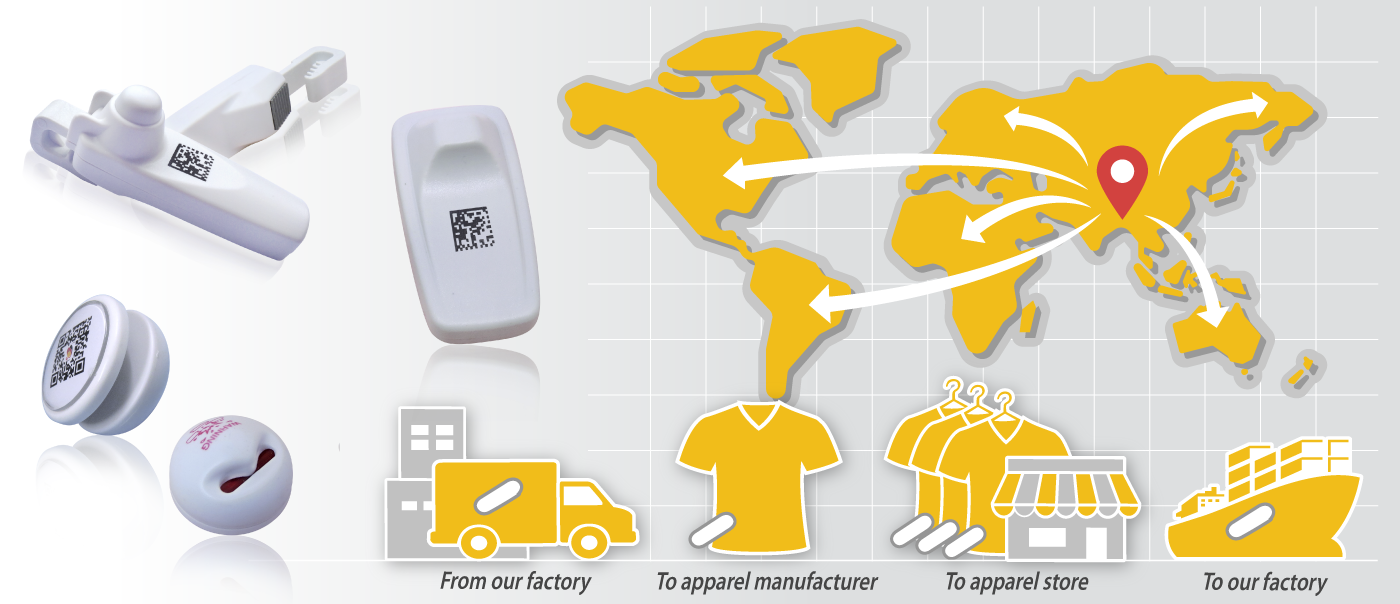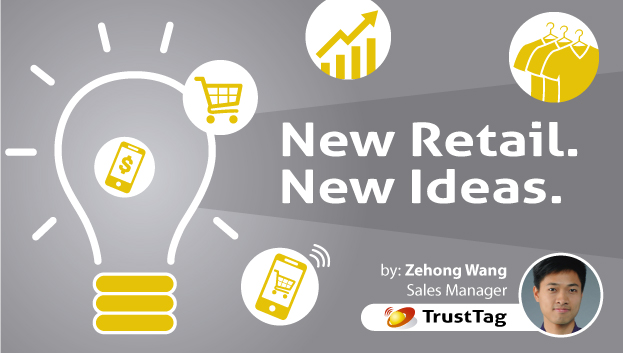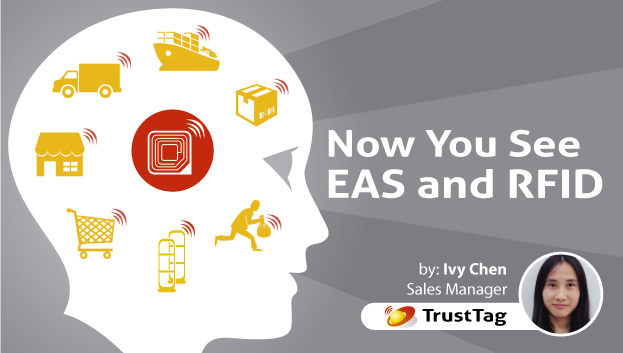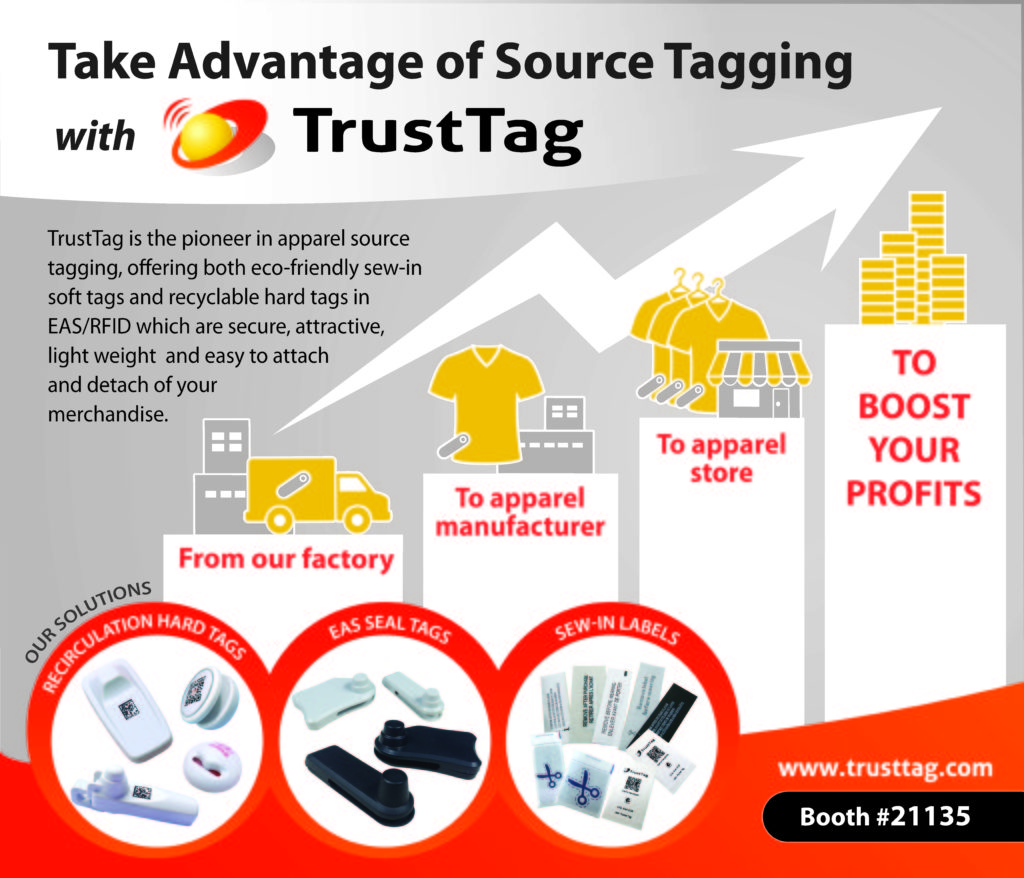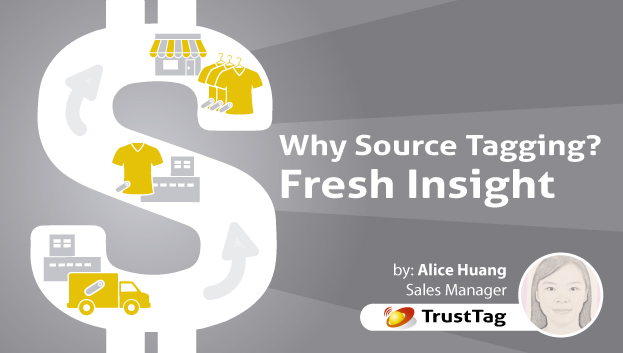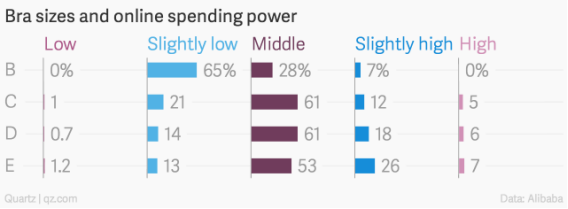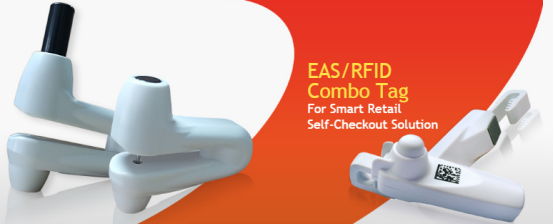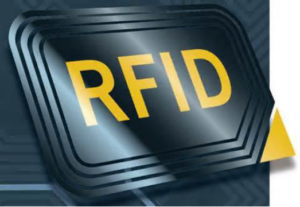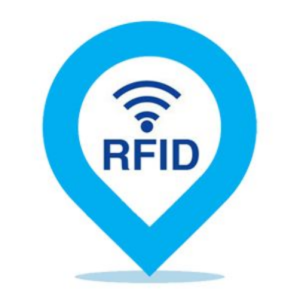Thursday, December 20, 2018
Saturday, November 10, 2018
Choosing Source Tagging For Increased Retail Security

By Simon Shi
Having a secure retail store is at the forefront of every merchant’s mind. And with theft being a constant threat to retail security, more stores are looking to source tagging as both an effective and painless way to bolster loss-prevention methods.
Not every retailer using these methods are implementing source tagging effectively; some are pointed in the entirely wrong direction. Let’s take a look at an overview of source tagging and how to make the best use of it for your retail store.
What is Source Tagging?
Source tagging (a type of Electronic Article Surveillance, or EAS), is when a small electronic device is embedded into packaging or is sewn unobtrusively onto the product itself. The tiny detectors are placed on products at or near the source (the supplier or manufacturer) rather than at the retailer.
The retailer’s vendors are authorized to obtain the tags and tag the items themselves before shipment, cutting down expensive labor costs for employee time spent tagging items in the store. Source tags come in a variety of shapes and sizes, but are always easy to handle and are incredibly effective for loss-prevention.
Why Retail Theft is a Problem
More companies are choosing to use source tagging because of the overwhelming statistics of shoplifting. In taking the United States into account, there are over 550,000 incidents of shoplifting per day, and a startling 13 billion dollars’ worth of goods stolen every single year – equating to 35 million dollars every day! Even 75 percent of employees have been found to engage in shoplifting.
Retail thieves are only caught 1 in 48 times, and they often wear large coats or use baby strollers, umbrellas, or large shopping bags to drop items into. Source tagging aids in mitigating the substantial losses incurred by retail losses.
Source Tagging Benefits
Source tagging is a reliable method for theft detection for products of any size or value. A Visible Source Tag (VST) extends high security and deterrence factors, and a sewn-in label can offer discreet EAS protection. Either option is easily deactivated or removed at the retail POS and chips away at valuable employee time often bogged down by tagging items. Additionally, source tagging decreases shrinkage, helps to increase in-stock rates, and can be a driving force in increasing sales. But above all, source tagging is one of the most effective ways to increase loss prevention.
How To Implement Source Tagging
The source tagging supplier you choose should be a professional entity and should be located close to a retailer’s manufacturing vendors. Many retailers in the United States choose their packing companies to aid with source tagging, which doesn’t end up working to the retailer’s advantage as manufacturers don’t provide the quality and professionalism that professional source tagging companies can offer. Source tagging companies communicate directly with vendors to ensure a retailer’s security needs are met. Make sure to choose trusted source tagging companies with dependable reputations – your products are your business, and your business is your livelihood!
TrustTag is a Chinese source tagging company that provides a myriad of source tagging and other precision-engineered security services for any manufacturers located in Asia. Contact us for any questions about how we can help your retail store mitigate loss prevention.
Friday, November 2, 2018
Will RFID Improve The Lost Prevention Function of Chinese Retail
Loss Prevention Committee of China General Chamber of Commerce announced that the Chinese retail lost value has reached 181 billion in 2016, commercial loss rate is 0.71% and it has been going up gradually in these recent 5 years. Internal and external theft is the main reason for the commercial loss. In the analysis report that the internal theft value is higher than the external theft. Therefore to control the internal theft is the main task in commercial loss prevention. Traditional loss prevention solution is not able to save retail loss prevention, that means loss prevention technology shall be upgraded.
Many big retailers domestic and international have led in modernized anti-theft solutions including EAS, CCTV, POS/EM and so on. EAS security system is ususally installed at the conspicuous place of the shopping mall or supermarket, and it can detect the active EAS security tags attached on the commodities items and trigger warning light and sound.
To use EAS anti-theft solution has powerful deterrent force on reducing external theft during retail stores opening. But the current EAS anti-theft security system has the defecs of low detection rate, faulse alarm, weak anti-interference, being shielded by metal, narrow protection range, non-recyclable EAS soft label and so on, which is already not able to meet the needs of existing anti-theft requirements.
CCTV acts mostly as a deterrent for external and internal theft and records the entire process of the event. While its shortcoming is that closed-circuit monitoring systems are usually installed in hidden locations to remotely monitor specific areas, and the camera’s viewing angles has not covered areas, so it is difficult to play a role at densely populated shopping mall. The CCTV system of the shopping mall needs to have a 24-hour special person for operating, generally speaking, it is difficult for someone in the actual operation to continuously monitor the image for a long time, so it cannot guarantee detection and suppression on the store theft intime.
The see from the above that the traditional retail loss prevention solution is not able to meet the current needs of the market. While in this time, RFID has brought new changes.
RFID has brough new changes to retail loss prevention.
- Quick cycle counting to reduce human losses.
After adopting RFID technology on the merchandise, managers can quickly cycle through the inventory and track the goods in real time. The staff only needs to check the inventory in the warehouse and sales area, monitor the real-time inventory, compare the differences and discover the changes of the goods during the operation, and clearly understand the loss of goods. In addition, the quickly counting feature of RFID can reduce the number of staff involved and reduce the theft rate.
Of course, the RFID technology comparing to EAS system, it still has the problem of weak protection of goods in the vicinity of the store entrance. At this stage, an RFID technology based EAS system, plus an RFID chip which is that a tag and two technologies can be for commodity protection and inventory management.
- Realize traceability of goods and reduce natural loss.
Low-temperature fresh food is prone to deterioration, using active temperature shelf label can sense the temperature and change real-time accurate price. With the handheld device, base station and software, it can display the freezer temperature in real time. When the temperature is high or low, the system will remind the staff to adjust the temperature in time through the background management system promptly to avoid the loss of food treatment caused by the power failure of the refrigerator.
In addition, the RFID shelf label can also display the existing inventory of the product in real time. Each time the item is sold, the system transmits the updated data to the sensing layer through the sensor. When the staff receives insufficient inventory, the product can be replenished in time.
- Automatic cashier to reduce cash loss.
The radio frequency tag based automatic cash register can instantly read the product information and complete the settlement on the helpf of radio frequency tag, without taking out the goods from the shopping basket and scanning the barcode one by one. The automatic cash register method reduces the cash loss caused during checking at the counter.
The functions of RFID achieving in the retail industry are not only preventing loss, but also improving the efficiency of the supply chain, the service quality of the store and so on. At present, the technology premium brought by RFID to the retail industry has begun to appear, and many retail companies have begun to deploy RFID systems.
Monday, October 1, 2018
R50X Hard Tag
Frequency: 8.2MHz
Dimension: Ø63mmx23mm (2.4″x9.05″)
Color: White
Lock: Three balls clutch, standard/super
Packing detail: 500pcs/carton
Size:380x290x250mm
GW: 8.0kg
This EAS retail security tag is compatible with Checkpoint, Nedap 8.2MHz (RF) EAS system.
[contact-form-7]
Tuesday, September 11, 2018
Sitemap
Pages
- Anti Theft Device
- Chinese
- Company
- Contact us
- Distributors
- Distributors Form
- Español
- ET-L061 Mini Golf Tag
- ET-L079 Whale Tag
- Fitting Room Guard
- French
- German
- Home
- Italian
- Japanese
- Korean
- Newsletters
- Order Free Whale Tag Samples
- Our Advantages
- Our Capabilities
- Our Company
- Our Product Lines
- Portuguese
- Privacy Policy
- RFID Printing & Encoding
- Russian
- Sitemap
- Solutions
- Terms of service
- Test Form Page
- Thank you!
- TrustTag in Europe
- TrustTag RFID Source Tagging
- TrustTag Source Tagging
- TrustTag’s Self-Checkout Solution
- VIP Room
Friday, August 3, 2018
Wednesday, June 27, 2018
TrustTag in Europe
Recently TustTag, your partner for loss prevention products, is represented in Europe as well. From our German office and warehouse we will serve the european clients and interested parties. Hence, there are no problems with time difference as you can contact them if you are from Europe. They are going help you in English or in German.
E-Mail: europe@trusttag.com
Phone: +40 (2102) 8791187
Or contact us below:
[contact-form-7]Fitting Room Guard
Anti-Theft Solution for Fitting Rooms
Dimension: 12,4cm x 6,7cm x 4cm
Color: White
Function: Dummy
Battery driven light
Security tags are often illegally removed in fitting rooms. This innovative Fitting Room Guard prevents those events by deterrent. In addition to the eye-catching design it has a battery-driven, flashing red light to simulate activity. The effect is proven and very successful. Get your Guard now for a special price.
Contact us for more information:
E-mail: europe@trusttag.com
Phone: +40 (2102) 8791187
or below:
[contact-form-7]
TrustTag Source Tagging
Safe Staff and Tagging Cost
- TrustTag in Europe sells the security tags directly to your garment factories.
- Your garment factories attach the tags to your apparel and then ships it secure and floor ready.
- The tags are removed at your POS and packed for shipping.
- TrustTag Europe’s Partner pays a rebate for each packed tag and collects them. TrustTag inspects and resells the tags to your garment factories.
TrustTag in Europe is one of the leading pioneers in apparel source tagging, where disposable security tags are reused. Because your garment factories buy the security tags and also attach them, you have enormous savings in tagging and staff/in store labor cost. Your security efficiency and visibility are also improved throughout your whole supply chain.There are no additional charges because TrustTag’s partner pays you a rebate when they collect the used security tags. Due to inspections of each recycled security tag, you are consequently guaranteed the best quality.You have security tags to spare? Use them for the TST or we offer to help you to sell them.You have more time for your customers, because your staff won’t be busy attaching the security tags.
Are you interested? Contact us:
E-mail: europe@trusttag.com
Phone: +40 (2102) 8791187
or below:
ET-L061 Mini Golf Tag
Special Priced Design Tag

Special Price: from 0.16$
Diameter: 42 mm
Thickness: 22 mm
Color: black
Lock: three balls, in bulk
The black two-piece mini golf tag convinces with its small, lightweight and attractive design. Therefore, it does not interfere with shopper experience or brand promotion. It works with RF technology and has a strong detection range due to its large circular coil. You can reuse the tag, because it’s not deactivatable.
Message us for more information or free samples:
E-mail: europe@trusttag.com
Phone: +40 (2102) 8791187
or below:
Friday, June 22, 2018
ET-L079 Whale Tag
NEW: RF & RFID Combo Hard Tag
Frequency: 8.2MHz, 58KHz, RFID(UHF), EAS&RFID Combo
Dimension:Φ53mm*20mm*60mm
Lock: Super/Standard
Color: White/Black or customized
Packing: 500pcs/ctn
TrustTag’s Whale Tag is easy to handle. Due to the integrated pin you can attach and detach it fast and safe with only one hand. It can be a combination of EAS and RFID to ease inventory management and Self-Checkout in addition to protecting apparels.
Contact us for more information via europe@trusttag.com or number or below:
[contact-form-7]Thursday, June 21, 2018
Friday, June 8, 2018
Thursday, June 7, 2018
Hard Tag Recirculation
Source Tagging is the process of applying and attaching an EAS hard tag onto an apparel or merchandise itself at the point of manufacture, then ship and deliver to the retail floor store directly for anti-shoplifting.
With hard tag recirculation, the hard tag itself requires tag removal at the retail POS and be packed and collected by shop assistance of the retailer to entrepot for hard tag supplier to pick up and ship back to the source of hard tag manufacture. Then back to the step of despatching the hard tag to the point of merchandise manufacturing for applying and tagging on, thus the hard tag recirculation.
Wednesday, June 6, 2018
Tuesday, May 29, 2018
AI – The Key to Smart Retail
In the last few years, AI(Artificial Intelligence) has become the most popular technology in industrial innovation. AI technology enhances the development of data analysis, AI robotics, language processing, computer vision, etc. And they are widely used in various area, like unmanned driving, aerospace, health care, manufacture, education, finance, etc. Today, we will talk about how retail industry benefits from AI technology, which enable retailers to explore what the customers are interested in to customize recommendation and improve customer experience greatly.
AI Online Store – Knows better what you are looking for
Based on data mining and deep learning, AI make the isolated massive data connected and much more valuable for easier customer analysis and better service. As mentioned in my other article “How Powerful Big Data Can Be to Retailers” , as long as retailers can use the big data well, they would also be able to predict sales and optimize their supply chains.
For example, when you search “Red Skirt” on Amazon, different log in account may have different search results based on the previous purchases. With the help of AI, amazons would recommend Red Skirts that are in fashion style and using fabric material you like while fitting your shape. This way, customer will be able to find what they need much quicker, while enjoying the individuation of the Red Skirt.
The AI search engine can do more than that. Have you ever seen something interested in buying but don’t know the name of it or even you know the name but still can’t find the exact same one online? No worries, with AI, now you can just take a picture and upload it to the shopping website like Ebay to find out the exact products you want!
Taking advantage of AI technology, online stores are also able to push products that you would most likely buy based on your previous purchase, not just random recommendation as before. In a word, AI knows you better, and help to find what you need faster!
AI Speaker – The entrance to a smart home
Since the Amazon Echo(Alexa) get into homes, they have been playing an important role in the interactive scenario to endow people easy access to the internet and different appliances at home. Now there are more and more AI Speakers in the market, like Google Home, Home Pod from Apple, Invoke from Microsoft etc. It is so magical about them that they will answer whatever questions you ask and execute commands. Just say out what you need and free your hands!
What is a day like with an AI Speaker? Waking up by the AI Speaker that is set to alarm at 6:00am, you ask it to open the curtain to enjoy the sunshine and your favorite music from AI Speaker. After some morning exercise, you ask AI speaker to turn down the AC and feel like to have a coke, but find out there’s no more in the fridge, so you ask AI Speaker to order some more drinks and fruits online to your fridge. AI Speaker can do much more than you can imagine, like call Uber to go out, ask it to turn on lights when get back home, to turn on the TV and choose your favorite TV show, to dim or turn off the light when you are ready to sleep and even play some white noise to helps with your sleep and have a sweet dream.
Now many AI Speaker suppliers are lowering the price a lot, even lower than the manufacturing cost. Why? Because they see a bright future for the huge smart appliances markets that they could probably take over simply by one small AI Speaker, which is playing an important role to control the smart home. Imagine that when people become addicted to control everything at home by speak to the AI Speaker, aren’t they going to buy more and more appliances that work with the AI Speaker? Amazon is acting quick to lead their way to take over the big smart retail market. And obviously other retailers are catching up to fight for the huge markets for smart appliances.
Magic Mirror – Help to tell what fits you better
For ladies, trying different colors of lipsticks can be very frustrated as they only have one month but therer are so many different brands and colors to try on. Even they try to clean the previous trial, there is still leftover that would affect the next trial. However, with the help of magic mirror, they will be able test different colors on their lips without actually trying it on. They only need to take out different lipsticks in front of the magic mirror, which will show different results accordingly.
Apparel stores also have been utilizing magic mirrors to help customers with choosing clothes of different styles and sizes and to try on various of combinations simply through a touch screen. This way, customers don’t need to wait to use the fitting room and put different clothes on and off any more. The magic mirror is also able to tell you what size and colors are available in stock and even receive your order to ask staffs to bring the clothes you need.
So how does magic mirror work to make this happen? First of all, in order to detect the apparels, retailers usually put RFID tags on apparels and RFID reader inside the Magic Mirror. This way, each apparel has their own identification that can be read in front of the magic mirror. After it is shown on the magic mirror, it will also help you to try on the apparel with different sizes and colors and recommend different combination with other apparels. Needless to say, AI technology contributes a lot to above customize process in selecting the satisfying apparels and complete a pleasant purchase.
Self-Checkout – No more lines
Since Amazon came up with the idea of Amazon Go in December, 2016, and started to roll out to the public in January, 2018, Self-Checkout has been highly touted in the retail industry. As the pioneer in Self-Checkout, Amazon Go’s grab-and-go shopping experience is made possible by the same types of technologies used in self-driving cars: computer vision, sensor fusion, and AI deep learning in the entire store.
However, because of the various complicated high-tech applied in Amazon Go stores, it would cost too much to build just a grocery store like that, so it is not practical to roll out stores like that in large scale for most retailers at the stage. Therefore, more and more Self-Checkout solutions are popping up with cheaper solutions and larger scale to take another step closer to consumers.
TrustTag is partnered on the Self-Checkout solution with QueueHop, one of world’s leading technology providers of autonomous retail checkout. For us, we have come up with two Self-Checkout solutions currently.
One is Smart Shopping Cart Solution for supermarkets or grocery stores. The cart is equipped with cameras, weighing system, touch screen and POS system that are enabled by technologies like deep learning, image recognition, neural network, sensor fusion, in-store navigation etc. to provide tailored recommendations and improve customer experience. With the AI technology, the cart is able to keep learning on identifying all products in stores to fulfill the scan-less image recognition tech. So customer only need to take and put whatever they want into the cart and checkout on the touch screen and POS on the smart cart. This is not as convenient as Amazon Go, but it cost 60% less, which is more practical to roll out in large scale for retailers.
TrustTag’s the other Self-Checkout Solution is designed for apparel stores, which is even cheaper, only 5% of the Amazon Go’s cost. Because retailers only need to equip the store with Self-Checkout Kiosks and tags that are based on EAS and RFID technology. For more details about this solution, please click here.
If you are interested in learning more about retails in the new era, please stay tuned for upcoming articles in our series of “New Retail, New Ideas”, which will explore details of specific technologies in new retail.
Wednesday, May 16, 2018
Sew-in Label
The sew-in labels are lightweight and easy to attach for the apparel manufacturers. At the same time, it’s one-time used and easy to remove for the customers before washing at home. The sew-in label source tagging solution has eliminated the tagging costs, reduced the shrinkage and increased the profitability for the retailers.
Trusttag has provided the sew-in label source tagging solution for the world’s leading apparel retailers, including both EAS sew-in labels and RFID sew-in labels. The first step is that Trusttag produces the designated sew-in labels and then deliver them to the apparel manufacturers all over the world. In the apparel factories, the factory workers attach the sew-in labels directly into the apparels. The last step is that the apparel factories ship and deliver the apparels to the retail stores and the retail stores do not need to attach the labels into the apparels by themselves.
Hard Tag Recirculation
Source Tagging is the process of applying and attaching an EAS hard tag onto an apparel or merchandise itself at the point of manufacture, then ship and deliver to the retail floor store directly for anti-shoplifting.
With hard tag recirculation, the hard tag itself requires tag removal at the retail POS and be packed and collected by shop assistance of the retailer to entrepot for hard tag supplier to pick up and ship back to the source of hard tag manufacture. Then back to the step of despatching the hard tag to the point of merchandise manufacturing for applying and tagging on, thus the hard tag recirculation.
Wednesday, May 9, 2018
TrustTag is Awarded A-Level Taxpayer
On April 19, 2018, Guangdong Local Taxation Bureau released a list of tax-paying credit rating of the year 2017 confirmed by Guangzhou Municipal Office, SAT & Guangzhou Municipal Local Taxation Bureau. There are five levels in the rating: A Level, B Level, M Level, C level and D Level (Best>>Worst). Expectedly, Virginland Technology Co., Ltd(TrustTag) is awarded A-Level Taxpayer on the rating.
As a taxpayer, what title of honor does an enterprise desire most? It must be A-Level Taxpayer on tax-paying credit rating. Becoming an A-Level taxpayer means it is a high-integrity enterprise and admitted to enjoy more convenient tax service. What’s more, if an enterprise won the honor of A-Level Taxpayer, it would be also assessed as A-class enterprise of Export Administration for more facilitation measures. Therefore, TrustTag insists on paying tax with honesty and integrity, in order to create a healthy trade and export environment for our respected customers consistently.
Tuesday, April 24, 2018
The defects of washing on RFID Source Tagging
Still remember we are talking about the basic information about RFID on my last chapter? What is RFID? You exactly got it, it’s Radio Frequency Identification. We talk about what it composes of, how it works and the most important is: why it works better than traditional barcode. On the last paragraph, we mention that: The RFID chips are loaded with electronic information. Today we would like to talk about if washing workable on RFID Source Tagging.(only refer to pocket label here)
Source tagging is not strange to us: it’s the application of delivering sew-in soft labels from tag factory to apparel manufacturers. Then, the apparel manufacturers sew the tags to the clothes during the sewing production. The last step is from the apparel manufacturers to customers store with the sew-in labels on the apparel. Obviously, the streamline tag factory-apparel manufacturers-customer stores saves the time of not sewing the tags to the apparel in the retail stores. RFID Source Tagging shares the same streamline, the only difference is that the RFID pocket labels are with RFID chips inside.
So what’s the defects of washing on RFID Source Tagging?
Firstly, we need to know the washing process of the apparel factories. There are some main types of apparel washing which share some main points during the washing process for the clothes: A lot of water, additive agents, special elements, high temperature at lasting time.
Secondly, based on the definition of RFID, we know that the RFID pocket labels are with the RFID chips which are loaded with electronic information. Usually speaking, the RFID chips not allowed to be immersed inside the water for long time although we say that the RFID chips are water-proof and satin-proof. When the RFID labels are splashed or dropped by water, it won’t have any affects on the RFID chips and it’s still workable. However, it’s still under a certain range. After the apparel factories sew in the RFID pocket labels to the clothes, the clothes need to be under washing process and it’s not what we understand about the water-proof. It’s not little water but mass water inside washing machine and rolling at high speed with different additive agents and lasting a certain time over 15minutes at least.
Though there are pocket labels that are specially made with anti-water function, the RFID chip inside the labels are still easy to be affected by the high temperature and corrosion at a certain lasting time. It’s just like the cellphone we use everyday, if it’s splashed or dropped by rain or unexpected water, the cellphone is still workable. But if you immerse the cellphone inside the water for some time, the electronics will be destroyed, too.
Washing process is not good for the RFID Source Tagging and it will damage the electronics inside the RFID chips to some extent. We know that the washing process is necessary for the apparel factories not only for the function, colors or safety. What we can suggest is that to put the process of sewing RFID pocket label after the washing process in the apparel factories.
Tuesday, April 3, 2018
Learn More about Source Tagging with TrustTag at ISC WEST
ISC WEST is coming up next week April 11-13 in Las Vegas. Click here to register for a FREE Expo Pass offered by TrustTag today.
Please stop by TrustTag’s booth#21135 to learn more about Source Tagging. See you next week!
Thursday, March 29, 2018
The ‘S’ and ‘W’ of hot-melt adhesive coating and ultrasonic cutting on Eas Pocket Label Tag
Eas pocket label tag is known as one of the security products to be used on garment clothing for retail stores anti-theft. The specialty of such kind of security label tag that different from normal hard tag is that it is more suitable for source tagging that to be tagging at source of manufacturing, and most importantly, cost-effective.
The security label tag is with Eas alarming soft label coated inside with fabric pocket, to be sewn on clothes. And how to make the alarming sensor soft label being coated with the fabric pocket? The normal and traditional production technics of the Eas pocket label tag is hot-melt adhesive coating on the fabric with the sensor alarming soft label.
Hot-melt adhesive glue is a kind of glue that does not have harm on the environment, and the glue is solid state in ordinary temperature, like massive, layer, strip or granular, which makes it convenient for easy package, storage, transport and usage. Moreover, when the glue is being hot-melt to coating on fabric, it can fastly stick and coat when the glue is cooling and curing. This makes the hot-melt adhesive glue quite fit for auto production line with high manufacturing efficiency. Because of these advantages of the hot-melt glue, therefore it’s widely and mostly used for Eas security pocket label tag’s manufacturing.
While at the same time, using hot-melt adhesive for security pocket label tag coating also has its own defects.
- Not great heat resistance and not strong enough adhesiveness; Have high requirement on hot-melting and coating equipment.
- Some of the hot-melt adhesive glue will easily turn to yellow when temperature is over 30℃, and it will be yellowing the fabric as well if in this case.
- The fabric can be wrinkle during hot-melt adhesive coating, thus the high requirement on coating equipment.
- The hot-melt adhesive coating fabric can be too stiff for sewing machine needle to pass through and has certain damage on sewing needle.
- Coating cost is a bit too high to manufacture with hot-melt adhesive glue.
- The fabric material will easily stick on the cutter because of the glue.
Due to the above listed defects of using hot-melt adhesive glue for security pocket tag coating, security pocket tag manufactures can receive oftenly claims from garment factories for not easy for sewing needle to pass through the pocket tag or from garment retailers that the yellowing on the fabric making their new clothes with stains and so on.
Based on the above facts and situation, security tag supplier has found out another better solution to solve the problems——Ultrasonic cutting technics.
Ultrasonic cutting is totally different from traditional cutting. Ultrasonic cutting is to use the power of ultrasonic transducer to heat and melt the cutting fabric material so fast as for cutting off. So ultrasonic cutting does not need sharp cutter edge or very strong pressure, and will not break or damage the cutting fabric edge. In this case the cutting sealing edge on the fabric will not have rough selvage, creases, silk running or laddering and so on.
Another big advantage of ultrasonic cutting is that, it fuses the fabric cutting part and automatically seals the cutting edge quite well when cutting on the fabric, avoiding fabric sealing edge turning loose. What’s more, the fabric material will not stick on the cutter even after ultrasonic fusing, which in some way to improve the cutting efficiency. And clothing factories do not need to worry about the damage on sewing machines needle when sew the label tag on.
The manufacturing efficiency is much higher with ultrasonic cutting technics comparing to the hot-melt adhesive coating so it’s now widely used by security tag manufactures. Ultrasonic cutting manufacturing can increase the production speed, expand production capacity and most importantly, highly reduce cost.
Thursday, March 1, 2018
Meet TrustTag at ISC WEST 2018 in Las Vegas
Dear Customer,
As ISC WEST (The International Security Conference & Exposition) is taking place soon in Las Vegas, NV, USA. We hereby sincerely invite you to visit our booth#21135 at the SANDS EXPO CENTER on April 11-13, 2018.
Since the company’s founding in 2004, TrustTag has focused on solving the problem of retail theft with various solutions while anticipating the needs of retailers. Leading retailers worldwide have been using TrustTag’s innovative and high quality EAS&RFID retail security products to help decrease shrinkage, enhance inventory management, and improve efficiency as well as customers experience. What’s more, by taking advantage of TrustTag’s Source Tagging solution, retailers will be able to protect and keep track of their merchandise throughout the supply chain.
Interested in attending the show and learn more about our solutions? Please click here to register for a FREE Expo Pass offered by TrustTag today. We look forward to meeting you at the show to communicate face to face soon!
Sincerely,
Simon Shi(President)
TrustTag
Tuesday, February 20, 2018
First simple look at Source Tagging
Comparing to traditional tagging and recirculation of reusable hard tags, today we are more attracted by source tagging solution in Electronic Article Surveillance (EAS), which emerged like 20 yeras ago. Source tagging solution is the process of embedding security label into any packaging or into the merchant itself at the source of manufacturing to protect the item from shoplifting at retail places.
Source tagging now is widely used in apparel & fashion accessories, electronics, food & beverage, health & beauty for the most part, and some other categories. And it will continue to expand and increase focus in the near future.
Now you still have no idea about how source tagging works in loss prevention? No worry, let us explain more.
Source Tagging is the process of despatching the EAS security tags or labels from tags manufacturer to the point of merchandise manufacturer, for example, garments, cosmetics, electronics, food, beverages and so on. The source tag will be embedded into the item itself during manufacturing at the sourcing place. Completed merchandise with source tag is shipped and despatched at the stores and being placed on sales floor. Through out all this process, retailers can reduce in-store labor costs incurred from applying security labels or hard tags inside the store and get complete reliability of the merchandise tagging.
To catch up with the development, TrustTag has devoted itself to source tagging solution for retail loss prenvetion to help retailers increase sales, solve shrink issues, and optimize store labor.
Wanna know more on retail source tagging, please follow us on LinkedIn, Twitter or YouTube Channel.
Friday, February 9, 2018
Holiday Notice
TrustTag office will be closed during Chinese New Year Holiday Feb.11-22, 2018. If you need anything, just leave a message and we will get in touch with you as soon as we are back from the holiday. Sorry for any inconvenience.
Wish you good fortune in the new year of 2018!
Thursday, February 8, 2018
How Powerful Big Data Can Be to Retailers
Starting from the 18th centuries, the way that how people use energy resources to drastically improve the efficiency has marked each industrial revolution. Coal along with the development of the steam engine, played central roles in the First Industrial Revolution. And it was oil and electricity to creat mass production in the Second Industrial Revolution. When it comes to the Third Industrial Revolution, we can think of nuclear energy, but it was also known as the Digital Revolution, in which internet just debuted in digital world and made the world connected.
We are now under the influence of the Fourth Industrial Revolution, which builds on the Digital Revolution by emerging technology breakthroughs in numerous fields like robotics, artificial intelligence, quantum computing and the Internet of Things. And for most of these, they rely a lot on one thing-big data, which is also regarded as the new form of “energy resource” in the new industrial revolution.
Jack Ma, founder of Alibaba Group, which has established the biggest e-commerce platform in China, used to tell a joke in his speech, “Do you know women living in which provinces in China have the biggest bra sizes and which provinces have the smallest in average? I know them all!” Beyond questions, other than this, Ma knows much more private things because Alibaba has the biggest database in China that has recorded the shopping habits of 500million users for over 10years.
Despite of the joke, Alibaba actually dig this deeper according to their database and found a curious trend: Women who bought larger bra sizes also tended to spend more online. As a result, Alibaba was able to target and analyze on different spending power and do better on tailored offers.
Another interesting story would be Walmart’s sales on diapers and beer, between which, there was a positive correlation when they analyzed the sales data. After some research, Walmart found out why. A man who was asked by his wife to buy a pack of diapers on his way home from work, would always fetch a pack of beer for himself to enjoy and relex on the couch after the long day, forgetting about the noise from the babies for a while. Seeing that, Walmart move the beer next to the diapers, and even make them a combo package for a better deal. As a result, the sales of both increased by 35%.
Other than the internal data, many retailers could also take advantage of external data to adjust their strategy. For example, when they find out there are hot keywords of some candies or hand spinner on twitter, facebook, instagram, retailers would increase the stock and put them in obvious shelf. Likewise, they would also adjust the supplies of some products according to the weather and traffic reports.
As for above examples, retailers are analyzing simple data to help with the sales. Still, they are just the tip of an iceberg, because the data they could use can be even more high-volume, high-velocity and high-variety. That is the so called big data, which is information assets that demand cost-effective, innovative forms of information processing that enable enhanced insight, decision-making, and process automation. For retailers, big data will definitely help optimize supply chain logistics, improve store layouts, customize recommendation, improve customer experience and boost the sales in the end.
So how can retailers obtain more valuable data on their own? Why not start with getting TrustTag’s RFID tags to the products and making them smart throughout the whole process. The efficiency will be highly improved with the RFID technology due to location-based data, smarter inventory checking and faster check out process(TrustTag is also offering Self-Checkout Solution for retailers). If you are using our RFID tags for Source Tagging, you will even be able to keep track of the products from the factory, through distribution, warehouse and finally to the sales floor as our RFID tags will obtain more and more information in the process of source tagging. And the more the data are used, the more valuable and powerful they will become!
If you are interested in learning more about retails in the new era, please stay tuned for upcoming articles in our series of “New Retail, New Ideas”, which will explore details of specific technologies in new retail.
Friday, February 2, 2018
A Brief Introduction to RFID
RFID, which is the abbreviation of Radio Frequency Identification, is an automatic identification technology widely used in logistics, retail, library, traffic, asset management, animal identification, etc.
RFID consists of the tag, the reader and the antenna. Tag is made up of the coupling element and the chip. The most important point is that every each tag has its own unique EPC(Electronic Product Code). The RFID reader can be hand-held or fixed device. The antenna plays a role of being a transmitter who transmits the signals between the tag and the reader.
So how RFID works? Actually it’s not so complicated. When the tag enter into the magnetic field, it receives the radiation signals from the reader. Based on the energy the tag obtains from the induced current, and then it sends out the chip information which has been stored inside the chip. This is about the passive tag. Another way is that the tag can sends out the signals actively, which is for the active tag. After the tag sends out the signals to the reader, the reader decodes the chip information to the central information system for the data.
As we introduce at the beginning, the RFID technology has been and will be used more and more popular in logistics, retail, library, traffic, asset management, animal identification and varieties of other fields. What’s the advantages make RFID so popular and practical in a great number of fields? Usually, people compare RFID with the traditional barcode since both of them are use for tracking the things in a fast and accurate way. But RFID shares more advantages than the traditional barcode from the below aspects:
- Fast scanning
Only one barcode can be scanned at one time. However, the RFID reader can identify many RFID tags at one time.
- Anti-stain and Wear resistance
The traditional barcode is on the paper so it’s to be stained by water or oil. RFID has well resistance to those things. Besides, RFID is not easy to be damaged as it runs in a ways of writing the data into the chips.
- Being reusable
The RFID tag can be added, modified or deleted for many times with large memory.
- Penetrability
RFID can identify the tag through paper or plastic or other non-metal materials while the barcode can only be identified only when there is no blocking.
- Safety
The RFID chips are loaded with electronic information and they are protected by code so the chip information are difficult to be altered.
RFID technology helps to effectively increase the efficiency of goods management, information management and logistics management especially in retail industry, let’s see!
